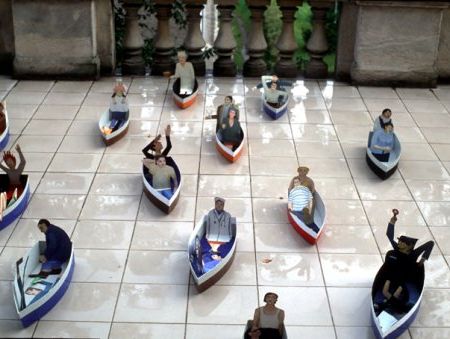The Laznia Centre for Contemporary Art in Gdanks is presenting between 26 September - 19 November 2006 a strange and interesting exbition with the title "Nomads of Nowadays", dedicated to the problem of mobility today and how the modern nomads, in the era of globalisation, are adapting nowadays. What are the consequences of this situation - large masses of people moving around - , how this situation is conflicting with cultural and ethnic identity, to what extent this mobility leads to one's alienation from his environement and form the others ? These are many questions, difficult ones, and yet the organisers are trying to provide accurate answers to each of them. The main question is what is the effect of cultural everyday encounters : multiculturalism or cultural homogenization?

The nomadic way of life is characteristic especially for those ethnic or social groups which are threatened with extinction because of the harsh living condition in their previous lands. In the past Mongolians, Gypsies or the Tuaregs were known for their nomadic life, almost a natural state for them. But for all the others, with the exception of those who needed to travel - sailors, merchants, soldiers - the idea of living their town or country was out of he question. It took a great amount of courage in order to leave your homeland, to discover other lands and cultures, and it was far better just to remain with what you already knew.
As the post-modern world dawned and technology permited easier and cheaper moving, the nomad phenomenon reappeared in modern life, as many left their cities to find new jobs and new sources of income. Also the military, political and economical conflicts changed the situation. For the first time in centuries a person is unsure of how much time he or she will spend in a certain place, so that dramatically changed the way we perceive the space around us. Everything, from furniture to eating or jobs is marked by this uncertainty. Space is no longer confined to the walls of the city, it became virtually without end, and this brings fear and panic. Also, because of this new rhytm of life, the modern nomadic as some might say, the relationships are affected, as we choose not to have any special feelings for eachother, sensing that soon we might have to leave.
But not only the everyday needs - food, shelter, protection - could determine us to leave our place in search for new horizons. Tourism is also a manifestation of mobility, motivated by simple pleasure and the curiosity of discovering new cultures and countries, it is the thirst for new images, concepts, ideas.
As for the artists, they are maybe the most mobile of the professional groups, and some will go around the world, either in person or by their works. Some chose to leave in order to discover new sources of inspiration and understand the world, others feel the need of change. The exhibition presented in Gdansk will try to answer to all these questions and problems using works of the artists preocuppied by this issue, among them being Piotr Wyrzykowski (Poland/Ukraine), Lars Mathisen (Denmark), Margareta Klingberg (Sweden), Dorota Podlaska (Poland), Zbigniew Wendt (Germany), Kyrill Koval (Germany), Ulric Roldanus (the Netherlands), Susan Hefuna (Germany/Egypt), Marta Deskur (Poland), R&Sie Studio (France), Vibeke Sjovoll (Norway), Agnieszka Wolodzko (Poland).
October 2006

































